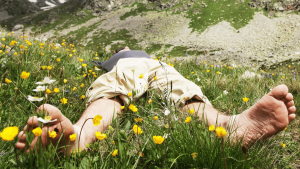Yoga Nidra is a beautiful and effortless way to enter a state of profound rest. It is a wonderful way to find your calm space.
Anxious, tired and stressed people arrive at my Yoga studio, desperate for rest. One of my greatest joys as a Yoga teacher is sharing the practice of Yoga Nidra. Yoga Nidra, literally translated as ‘yogic sleep’, is a safe and easy way to enter the healing space between waking and deep sleep. After a few gentle movements and stretches to settle the body, we lie down comfortably with plenty of cushion and blankets. A soothing aroma of lavender or frankincense wafts through the air. The lights are turned down low. Once everyone is cosy, I begin to speak, reassuring everyone that we are safe here. There is no way of doing this wrong. All you have to do is relax….
An Ancient Practice
Yoga Nidra is an ancient practice, referred to in Indian epic poetry and Medieval Hatha Yoga manuals. It has been developed in modern times by Swami Satyananda and his followers in India as well as by Richard Miller, Rod Stryker, Nirlipta Tuli and Uma Dinsmore-Tuli among others across the world. Yoga Nidra has been researched and developed by western psychologists as well as by traditional gurus. It has been used in the military as a therapy for PTSD. There are many styles of Yoga Nidra, and the practice continues to evolve[i][ii].
Benefits of Yoga Nidra
Yoga Nidra is a deep guided relaxation and meditation. It slows down brainwaves and enables practitioners easily to enter a space of deep calm and rest. When you practice Yoga Nidra you go into the parasympathetic state where the body and mind naturally recuperate from stress, healing occurs and the immune system can work well.
Yoga Nidra is an excellent way to improve heart rate variability which relates closely to the health of the nervous system[iii]. The practice releases dopamine in the brain and helps you feel wonderful[iv]. It is effective for the management of chronic pain and is used in the treatment of PTSD[v].
Yoga Nidra boosts self-esteem and relieves anxiety[vi]. It increases creativity and aids self-discovery. It is also great for exhaustion and depression. So many are the benefits of Yoga Nidra that it is valuable for everyone. The Yoga Nidra Network describes it as an ‘adaptogenic practice’[vii]. This means that the practice of Yoga Nidra will meet your current needs, whether these are for sleep, productivity, dealing with specific problems or a spiritual journey. Yoga Nidra is helpful for everyone.
What Happens During Yoga Nidra?
There are different styles and structures of Yoga Nidra, but all have many aspects in common. Once you are lying down in a restful position and covered with a blanket, the teacher will guide you though an initial settling and relaxation. This may include breath awareness, diaphragmatic breathing and setting an intention.
Sankalpa
Yoga Nidra often includes an invitation to seek a Sankalpa or heartfelt desire. This is an awareness of a deep inner wish or resolve. You may have an intention just for today’s practice, or a sankalpa may refer to a deeper, even lifelong goal.
Body Awareness
Yoga Nidra nearly always includes a mental journey around the body, resting your consciousness on each body part in turn. Your teacher will guide you as you focus your awareness on different points on your body. This experience is deeply calming and helps ease you into a dreamlike state.
Breath and Opposites
Then there may be a focus on the natural rhythm of the breath, and usually suggestions to observe pairs of opposite feelings or emotions. You may be invited to imagine heat and cold, happiness and sorrow, heaviness and lightness. This may be followed by more breath awareness.
Guided Visualisation and Silence
Many forms of Yoga Nidra now involve some form of guided visualisation or inner awareness. You may be taken on an imaginative journey through mountains, forests or gardens. You may be asked to visualise a series of images. You may be invited to witness the space behind your closed eyes. This is a time for dreamlike visions and deep rest. It may become a journey of self discovery. Your teacher may leave a period of silence for you to continue your inner exploration and enjoy this profound place of relaxation.
Return to the Waking World
After revising your sankalpa or heart’s desire, your teacher will slowly and gently guide you back to the waking state. You may close with a few moments of gratitude for the blessings of the practice. Chanting Om or another mantra is a lovely way to close the practice of Yoga Nidra.
Afterwards
After Yoga Nidra you will probably feel very calm and sleepy. It can take some time to return to full wakefulness. If my students have to travel home after their practice I always give them a snack to eat and make sure they are fully awake so that they can drive home safely. It is especially good to practice Yoga Nidra before bedtime. You will be able to snuggle down afterwards for an excellent night’s sleep.
Learn More
If you would like to learn more about Yoga Nidra, I highly recommend the website of the Yoga Nidra Network. Here you can find free recordings, training courses and lots of information about this wonderful practice:
https://www.yoganidranetwork.org/
Today’s Calming Practice – Yoga Nidra
The best way to experience Yoga Nidra is in a group or one to one with an experienced and qualified teacher. Many classes are available, both online and in person. However you can also enjoy many of the benefits by listening to good recordings.
This link will take you to a selection of free recordings of Yoga Nidra provided by the excellent Yoga Nidra Network. Choose one, lie down comfortably, and enjoy all the benefits of Yoga Nidra:
https://www.yoganidranetwork.org/downloads-filtered?field_language_tid_selective=266
Thanks for reading this blog post. I am writing a series of 31 blogs every day this August. I plan to publish them later in the year as a book entitled, ‘Finding Your Calm Space – 31 Ways to Find Calm in a Crazy World’.
CLICK HERE TO DOWNLOAD A FREE GUIDED BREATH COUNTING MEDITATION VIDEO
I’m Karen. I am a Yoga teacher, Reflexologist and busy mum of seven. I live with my family in Billericay, Essex, UK. In the past I have worked as a Midwife, Health Visitor, Baby Signing teacher and Tax Inspector. I love getting outdoors, swimming in the sea, walking and writing. Helping people relax is one of the things I do best.
You can learn more about my Yoga classes and Reflexology at my website www.thecalmspace.co.uk
[i] https://en.wikipedia.org/wiki/Yoga_nidra
[ii] https://www.ekhartyoga.com/resources/styles/yoga-nidra#:~:text=Yoga%20Nidra%20is%20an%20ancient,1000%20BC%20through%20verbal%20teaching).&text=Yoga%20Nidra%20continues%20to%20evolve.
[iii] https://www.liebertpub.com/doi/10.1089/acm.2011.0331
[iv] https://www.sciencedirect.com/science/article/abs/pii/S0926641001001069?via%3Dihub
[v] https://apps.dtic.mil/dtic/tr/fulltext/u2/a523510.pdf
[vi] https://www.sciencedirect.com/science/article/abs/pii/S1744388118308089?via%3Dihub




